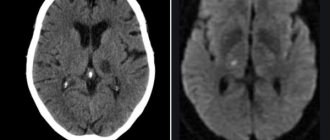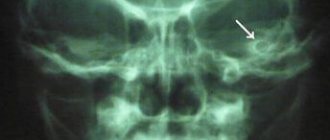Atarax®
Contraindications for joint use.
Co-administration of hydroxyzine with drugs known to prolong the QT interval and/or cause torsade de pointes (TdP), for example, class IA (such as quinidine, disopyramide) and class III antiarrhythmics (such as amiodarone, sotalol), some antihistamines drugs, some antipsychotics (eg, haloperidol), some antidepressants (eg, citalopram, escitalopram), some antimalarials (such as mefloquine and hydroxychloroquine), some antibiotics (such as erythromycin, levofloxacin, moxifloxacin), some antifungals (eg, pentamidine ), certain drugs used to treat gastrointestinal problems (such as prucalopride), certain drugs used to treat cancer (such as toremifene, vandetanib), and methadone, which increases the risk of heart rhythm problems. Therefore, such combinations are contraindicated.
Co-prescription of drugs requiring special precautions during use
Caution is required when using drugs that cause bradycardia and hypokalemia.
Caution is required when using hydroxyzine in doses higher than recommended in patients receiving concomitant treatment with drugs with arrhythmogenic effects: quinidine, lithium, thioridazine, tricyclic antidepressants, atropine, etc.
The potentiating effect of hydroxyzine should be taken into account when using the drug together with drugs that have a depressant effect on the central nervous system or have anticholinergic properties; in this case, the dose should be selected individually.
Alcohol also potentiates the effect of hydroxyzine. Concomitant use of hydroxyzine with monoamine oxidase inhibitors should be avoided.
In the case of treatment with anticoagulants, control of hemostasis is necessary at the beginning of therapy.
Hydroxyzine exhibits antagonistic properties towards betahistine and anticholinesterase drugs. Treatment should be stopped at least 5 days before an allergy test or a provocative test for bronchial reactivity with methacholine to avoid affecting the study results.
The administration of hydroxyzine may affect the results of determination of 17-hydrocorticosteroids in urine.
Hydroxyzine counteracts the pressor effect of adrenaline.
When used in rats, hydroxyzine antagonized the anticonvulsant effects of phenytoin.
Cimetidine at a dose of 600 mg divided into 2 doses per day caused an increase in the concentration of hydroxyzine in the blood serum by 36% and a decrease in the maximum concentration of the cetirizine metabolite by 20%.
Hydroxyzine is a CYP2D6 inhibitor (enzyme release rate constant (Ki): 3.9 µmol; 1.7 µg/ml) and in high doses can lead to drug interactions with CYP2D6 substrates (metoprolol, propafenone, timolol, amitriptyline, clomipramine, desipramine , imipramine, paroxetine, haloperidol, risperidone, thioridazine, aripiprazole, codeine, dextromethorphan, duloxetine, flecainide, mexiletine, ondansetron, tamoxifen, tramadol, venlafaxine).
Hydroxyzine at a concentration of 100 μmol does not have an inhibitory effect on uridine diphosphate (UDP)-glucuronyltransferase isoforms 1A1 and 1A6 in human liver microsomes. It inhibits cytochrome P450 isoforms 2C9/C10, 2C19 and 3A4 at plasma concentrations exceeding the maximum (IC50 (mean concentration required to achieve half maximum inhibition): 103-140 µmol; 46-52 µg/ml). Therefore, it is unlikely that hydroxyzine can disrupt the metabolism of drugs that are substrates for these enzymes.
The cetirizine metabolite at a concentration of 100 µmol does not have an inhibitory effect on liver cytochrome P450 (1A2, 2A6, 2C9/C10, 2C19, 2D6, 2E1 and 3A4) and isoforms of UDP-glucuronyltransferase.
Hydroxyzine is metabolized by alcohol dehydrogenase and CYP3A4/5.
An increase in the concentration of hydroxyzine in the blood can be expected when it is used simultaneously with drugs that are inhibitors of these enzymes (telithromycin, clarithromycin, delavirdine, stiripentol, ketoconazole, voriconazole, itraconazole, posaconazole and some HIV protease inhibitors, including atazanavir, indinavir, nelfinavir, ritonavir, saquinavir, lopinavir/ritonavir, saquinavir/ritonavir and tipranavir/ritonavir). However, when only one metabolic pathway is inhibited, the effect can be partially compensated by other metabolic pathways.
Atarax
Atarax (INN hydroxyzine) is a tranquilizer from the Belgian pharmaceutical company UCB Pharma, SA. It was developed in the mid-50s of the last century and became the world's first non-benzodiazepine tranquilizer. He laid the foundation for a new class of drugs called ataractics. Largely thanks to Atarax (and only later - Viagra), a small pharmaceutical company at that time, which received a license to distribute the drug in the United States, grew to become a global giant and industry leader.
As a tranquilizer, Ataracas exhibits anxiolytic (suppresses anxiety) and sedative effects. In addition to this, the drug has an antihistamine (blocks histamine H1 receptors), m-cholinergic blocking (inactivates central m-cholinergic receptors) and antiemetic effects. It is important that pathological dependence does not develop to the drug. The pharmacological effect develops 20-30 minutes after the active substance enters the gastrointestinal tract. The drug normalizes cognitive functions (memory, mental performance, attention). Relaxes striated and smooth muscles. Dilates the bronchi. Has an analgesic effect. Suppresses the release of digestive enzymes into the lumen of the stomach. Reduces itching in allergic manifestations and dermatological diseases (dermatitis, eczema). With a long course of medication, after the end of taking the drug, withdrawal syndrome does not develop and there is no deterioration in cognitive activity.
A polysomnographic study in patients suffering from insomnia and anxiety disorders demonstrates a significant increase in sleep duration and a decrease in the number of episodes of awakenings at night after taking a single dose of Atarax. A decrease in muscle hypertonicity with increased anxiety has been demonstrated when taking Atarax at a dose of 50 mg three times a day. The drug is well absorbed from the gastrointestinal tract: its maximum plasma concentration is recorded two hours after oral administration. The bioavailability of hydroxyzine is 80%. Penetrates through the BBB, metabolic products enter breast milk. The half-life is 14 hours. The side effects inherent in the drug are mainly associated with the anticholinergic effect: hyposalivation, difficulty urinating, constipation, spasm of accommodation. Atarax is incompatible with ethanol, so during the medication course you should refrain from consuming ethanol-containing products. When taking the drug, it is necessary to take into account that hydroxyzine can slow down the reaction rate and impair concentration. Atarax enhances the effect of drugs that suppress the activity of the central nervous system: opioid painkillers, tranquilizers, barbiturates, sedatives. If it is necessary to combine them, you should be especially careful when choosing drugs.
Atarax, 25 pcs., 25 mg, film-coated tablets
Contraindications for joint use.
Co-administration of hydroxyzine with drugs known to prolong the QT interval and/or cause torsade de pointes (TdP), for example, class IA (such as quinidine, disopyramide) and class III antiarrhythmics (such as amiodarone, sotalol), some antihistamines drugs, some antipsychotics (eg, haloperidol), some antidepressants (eg, citalopram, escitalopram), some antimalarials (such as mefloquine and hydroxychloroquine), some antibiotics (such as erythromycin, levofloxacin, moxifloxacin), some antifungals (eg, pentamidine ), certain drugs used to treat gastrointestinal problems (such as prucalopride), certain drugs used to treat cancer (such as toremifene, vandetanib), and methadone, which increases the risk of heart rhythm problems. Therefore, such combinations are contraindicated.
Co-prescription of drugs requiring special precautions during use
Caution is required when using drugs that cause bradycardia and hypokalemia.
Caution is required when using hydroxyzine in doses higher than recommended in patients receiving concomitant treatment with drugs with arrhythmogenic effects: quinidine, lithium, thioridazine, tricyclic antidepressants, atropine, etc.
The potentiating effect of hydroxyzine should be taken into account when using the drug together with drugs that have a depressant effect on the central nervous system or have anticholinergic properties; in this case, the dose should be selected individually.
Alcohol also potentiates the effect of hydroxyzine. Concomitant use of hydroxyzine with monoamine oxidase inhibitors should be avoided.
In the case of treatment with anticoagulants, control of hemostasis is necessary at the beginning of therapy.
Hydroxyzine exhibits antagonistic properties towards betahistine and anticholinesterase drugs. Treatment should be stopped at least 5 days before an allergy test or a provocative test for bronchial reactivity with methacholine to avoid affecting the study results.
The administration of hydroxyzine may affect the results of determination of 17-hydrocorticosteroids in urine.
Hydroxyzine counteracts the pressor effect of adrenaline.
When used in rats, hydroxyzine antagonized the anticonvulsant effects of phenytoin.
Cimetidine at a dose of 600 mg divided into 2 doses per day caused an increase in the concentration of hydroxyzine in the blood serum by 36% and a decrease in the maximum concentration of the cetirizine metabolite by 20%.
Hydroxyzine is a CYP2D6 inhibitor (enzyme release rate constant (Ki): 3.9 µmol; 1.7 µg/ml) and in high doses can lead to drug interactions with CYP2D6 substrates (metoprolol, propafenone, timolol, amitriptyline, clomipramine, desipramine , imipramine, paroxetine, haloperidol, risperidone, thioridazine, aripiprazole, codeine, dextromethorphan, duloxetine, flecainide, mexiletine, ondansetron, tamoxifen, tramadol, venlafaxine).
Hydroxyzine at a concentration of 100 μmol does not have an inhibitory effect on uridine diphosphate (UDP)-glucuronyltransferase isoforms 1A1 and 1A6 in human liver microsomes. It inhibits cytochrome P450 isoforms 2C9/C10, 2C19 and 3A4 at plasma concentrations exceeding the maximum (IC50 (mean concentration required to achieve half maximum inhibition): 103-140 µmol; 46-52 µg/ml). Therefore, it is unlikely that hydroxyzine can disrupt the metabolism of drugs that are substrates for these enzymes.
The cetirizine metabolite at a concentration of 100 µmol does not have an inhibitory effect on liver cytochrome P450 (1A2, 2A6, 2C9/C10, 2C19, 2D6, 2E1 and 3A4) and isoforms of UDP-glucuronyltransferase.
Hydroxyzine is metabolized by alcohol dehydrogenase and CYP3A4/5.
An increase in the concentration of hydroxyzine in the blood can be expected when it is used simultaneously with drugs that are inhibitors of these enzymes (telithromycin, clarithromycin, delavirdine, stiripentol, ketoconazole, voriconazole, itraconazole, posaconazole and some HIV protease inhibitors, including atazanavir, indinavir, nelfinavir, ritonavir, saquinavir, lopinavir/ritonavir, saquinavir/ritonavir and tipranavir/ritonavir). However, when only one metabolic pathway is inhibited, the effect can be partially compensated by other metabolic pathways.
Atarax tablet p/pl/o 25 mg N25 (USB Pharma)
Contraindications for joint use.
Co-administration of hydroxyzine with drugs known to prolong the QT interval and/or cause torsade de pointes (TdP), for example, class IA (such as quinidine, disopyramide) and class III antiarrhythmics (such as amiodarone, sotalol), some antihistamines drugs, some antipsychotics (eg, haloperidol), some antidepressants (eg, citalopram, escitalopram), some antimalarials (such as mefloquine and hydroxychloroquine), some antibiotics (such as erythromycin, levofloxacin, moxifloxacin), some antifungals (eg, pentamidine ), certain drugs used to treat gastrointestinal problems (such as prucalopride), certain drugs used to treat cancer (such as toremifene, vandetanib), and methadone, which increases the risk of heart rhythm problems. Therefore, such combinations are contraindicated.
Co-prescription of drugs requiring special precautions during use
Caution is required when using drugs that cause bradycardia and hypokalemia.
Caution is required when using hydroxyzine in doses higher than recommended in patients receiving concomitant treatment with drugs with arrhythmogenic effects: quinidine, lithium, thioridazine, tricyclic antidepressants, atropine, etc.
The potentiating effect of hydroxyzine should be taken into account when using the drug together with drugs that have a depressant effect on the central nervous system or have anticholinergic properties; in this case, the dose should be selected individually.
Alcohol also potentiates the effect of hydroxyzine. Concomitant use of hydroxyzine with monoamine oxidase inhibitors should be avoided.
In the case of treatment with anticoagulants, control of hemostasis is necessary at the beginning of therapy.
Hydroxyzine exhibits antagonistic properties towards betahistine and anticholinesterase drugs. Treatment should be stopped at least 5 days before an allergy test or a provocative test for bronchial reactivity with methacholine to avoid affecting the study results.
The administration of hydroxyzine may affect the results of determination of 17-hydrocorticosteroids in urine.
Hydroxyzine counteracts the pressor effect of adrenaline.
When used in rats, hydroxyzine antagonized the anticonvulsant effects of phenytoin.
Cimetidine at a dose of 600 mg divided into 2 doses per day caused an increase in the concentration of hydroxyzine in the blood serum by 36% and a decrease in the maximum concentration of the cetirizine metabolite by 20%.
Hydroxyzine is a CYP2D6 inhibitor (enzyme release rate constant (Ki): 3.9 µmol; 1.7 µg/ml) and in high doses can lead to drug interactions with CYP2D6 substrates (metoprolol, propafenone, timolol, amitriptyline, clomipramine, desipramine , imipramine, paroxetine, haloperidol, risperidone, thioridazine, aripiprazole, codeine, dextromethorphan, duloxetine, flecainide, mexiletine, ondansetron, tamoxifen, tramadol, venlafaxine).
Hydroxyzine at a concentration of 100 μmol does not have an inhibitory effect on uridine diphosphate (UDP)-glucuronyltransferase isoforms 1A1 and 1A6 in human liver microsomes. It inhibits cytochrome P450 isoforms 2C9/C10, 2C19 and 3A4 at plasma concentrations exceeding the maximum (IC50 (mean concentration required to achieve half maximum inhibition): 103-140 µmol; 46-52 µg/ml). Therefore, it is unlikely that hydroxyzine can disrupt the metabolism of drugs that are substrates for these enzymes.
The cetirizine metabolite at a concentration of 100 µmol does not have an inhibitory effect on liver cytochrome P450 (1A2, 2A6, 2C9/C10, 2C19, 2D6, 2E1 and 3A4) and isoforms of UDP-glucuronyltransferase.
Hydroxyzine is metabolized by alcohol dehydrogenase and CYP3A4/5.
An increase in the concentration of hydroxyzine in the blood can be expected when it is used simultaneously with drugs that are inhibitors of these enzymes (telithromycin, clarithromycin, delavirdine, stiripentol, ketoconazole, voriconazole, itraconazole, posaconazole and some HIV protease inhibitors, including atazanavir, indinavir, nelfinavir, ritonavir, saquinavir, lopinavir/ritonavir, saquinavir/ritonavir and tipranavir/ritonavir). However, when only one metabolic pathway is inhibited, the effect can be partially compensated by other metabolic pathways.











